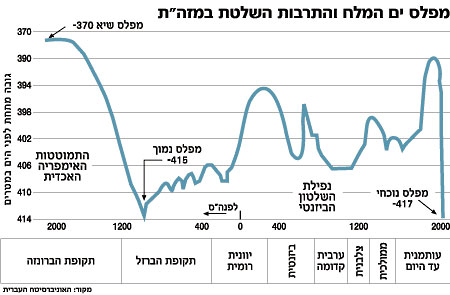Measuring the changes in the level of the Dead Sea over thousands of years supports the hypothesis that the decline of the ruling empires in the Middle East is related to climate change
Ran Shapira, Haaretz, Walla News!

Direct link to this page: https://www.hayadan.org.il/deadseadrops.html
Five times in the last 4,000 years there has been a significant and continuous drop in the level of the Dead Sea. Each such low period represents a prolonged drought in the Middle East, which was probably accompanied by a cultural change in the region. The most dramatic period of depression in the last 5,000 years began around 2300-2200 BC and lasted until about 1500 BC. The beginning of this drought was accompanied by the decline of the Akkadian Empire, which was centered in present-day southeastern Turkey, and of the Early Bronze Age in the Levant. Another drop in the lake level began around 500 AD and ended more than 400 years later, close to the fall of the Byzantine rule in Israel, following which the Arab tribes invaded the region.
During the periods when the level of the Dead Sea rose simultaneously with a significant increase in the amount of precipitation in the north and center of Israel, the cultural trend was flourishing and prosperity. In the second and first centuries BC the level of the lake reached one of its peaks and at the same time the Roman Empire erected magnificent buildings in the area, paved roads and built waterworks. The flourishing of Byzantine culture, in the fourth century AD, was also accompanied by an impressive rise in the water level in the lake, and 700 years later, in the 11th and 12th centuries, the Crusaders who came to the Holy Land found the Dead Sea at a high level.
The correspondence between the time of climatic changes and cultural changes in the Middle East is a hypothesis that has been discussed in the past, says Prof. Yehuda Anzel from the Hebrew University, but in many cases there was a lack of sufficiently detailed data on climate in the historical past. Prof. Aryeh Isser, a geologist from the Desert Research Institute at Ben-Gurion University, and Dr. David Niv from the Geological Institute long ago claimed that the decline of the magnificent culture that characterized the Early Bronze Age in the Middle East, in the second half of the third millennium BC, is related to the warming that caused the area to dry out.
The data on the level of the Dead Sea were collected by Prof. Anzel and Dr. Roital Bookman with a team of researchers from the Institute of Earth Sciences at the Hebrew University at two sites on the shores of the Dead Sea. The researchers analyzed the types of layers that indicate the exact height of the water level in the salt lake in different periods and determined their age based on the dating of plant remains found in them using the carbon 14 method. The research provided accurate data on the level changes over the past thousands of years, which matched data from previous excavations.
The next step was to check the relationship between the level of the Dead Sea and the amount of precipitation in the Middle East. In the absence of accurate data on precipitation in ancient times, the researchers used data from the twentieth century. First they focused on the two main sources of the Dead Sea - the mountains in the east and west and the Jordan River. In an article published in the last issue of the journal Society of America Bulletin "Geological" the researchers wrote that there is a match between the precipitation in the Jerusalem area and the amount of water added to the Dead Sea: in dry years, when less than 500 millimeters of rain fall in Jerusalem, the supply of water to the Dead Sea is affected. The level of precipitation in the Upper Galilee and the Golan, where the sources of the Jordan are located, corresponds in most years to that in Jerusalem.
After that, Anzel and his partners expanded the research and found that series of years with rain in Israel are also years with little precipitation in the entire Middle East. Hence the decline of the Akkadian culture, whose center was about 1,000 kilometers from the Dead Sea, was linked to a regional climatic change, which at the same time affected southeastern Turkey and the Levant.
The civilizations that declined in size with the descent to the Dead Sea were largely based on agriculture. Their prosperity depended largely on a good water supply, which increased the flow of the Jordan into the Dead Sea and raised its level. On the other hand, the increased rain irrigated Baal's fields and increased crops and provided water for the emergence of the hundreds of small springs common in the mountain area. These springs are very sensitive to changes in rain and their effect fades and even stops following a succession of dry years. However, Prof. Anzel emphasizes that cultural changes are not only related to the climate, but also to political, religious, and other circumstances.
https://www.hayadan.org.il/BuildaGate4/general2/data_card.php?Cat=~~~900035286~~~158&SiteName=hayadan

One response
And yet, what exactly is being done to preserve the Dead Sea??